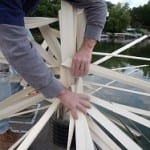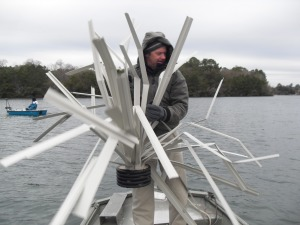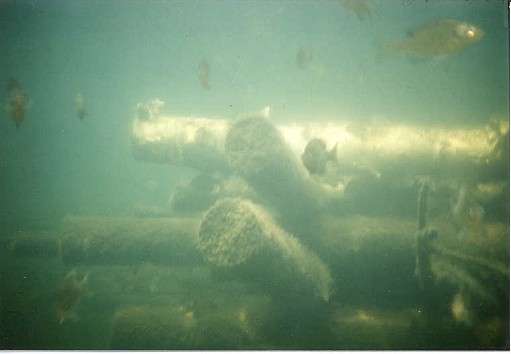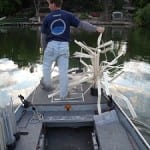
Tonia Burns, natural resources coordinator for the North Clackamas Parks and Recreation District, left, tells tour participants about the district’s local partners in watershed projects.
Although there was no stated theme for the second annual watershed tour sponsored by the North Clackamas Urban Watersheds Council, speakers all noted the power of people working together to improve watershed health in Oak Grove, Jennings Lodge and Gladstone.
The council’s mission is to advocate for the protection and enhancement of the watersheds’ fish and wildlife habitat and improve water quality through partnership with public and private entities, habitat restoration projects, community education and outreach and strategic planning.
See the dozens of unique artificial fish habitat models, fish attractors and fish cover used at fishiding.com, the industry leader and only science based, man made and artificial fish habitat, proven to provide all fish with cover they prefer to prosper.
Oak Grove resident Eleanore Hunter, current chair of the Oak Lodge Community Council, told the group that the whole idea of citizens and organizations cooperating with one another is to create an “integrated habitat” for humans, animal, fish and the environment.
It’s all about “connectivity” and an “incredibly supportive community,” she added.
Restoring watershed health will ultimately result in “the ability to introduce fish [in streams] along River Road,” said Chips Janger, one of the founders of Clackamas County Urban Green, an organization dedicated to supporting tree conservation in the county.
“People who are really interested are joining together and we have a lot of power,” he added.
The tour began at Meldrum Bar State Park in Gladstone and stopped at four key locations in the River Forest, Boardman and Rinearson Creek watersheds; these watersheds all flow off Oatfield Ridge and feed into the Willamette River.
As the tour progressed, neighborhood and agency experts discussed habitat, hydrology and water quality and shared their plans to improve watershed conditions for people, fish and wildlife.
Brett Arvidson, the manager of planning and engineering for the Oak Lodge Sanitary District, talked to the group about the recent Metro Nature in the Neighborhood grant for a fish habitat restoration project in the Boardman Creek and Walta Vista area in Jennings Lodge.
The $485,000 grant will replace two culverts near the mouth of Boardman Creek with bridges, allowing fish to return to more than a mile of the creek. He said it is important to note that the grant marks a partnership among the North Clackamas Urban Watershed Council, Oak Lodge Community Council, Jennings Lodge Citizen Participation Organization, Clackamas County Urban Green and North Clackamas Parks & Recreation District.
The total cost of the project will be around $1.7 million and take between three to four years to finish, Arvidson said, because it will involve “a complicated piece of engineering.”
Watershed education
People live all around the creek, where construction will take place, so educating homeowners about watershed health is key, added Tonia Burns, natural resources coordinator for the North Clackamas Parks and Recreation District.
Residents need to be aware of the natural processes that occur in a creek and be careful about what they plant, Arvidson noted, adding, “We want to encourage shade along the creeks,” to provide the best fish habitat.
In the past, the streams were treated poorly, when they were covered up or directed into culverts, leaving fish with no place to go, noted William Wild, president of the Oak Lodge Sanitary District.
“If we can open up the Walta Vista area, we can open up a big piece of the puzzle. We have the greatest partnership with North Clackamas Parks and Recreation. We’ve been involved with them at all the parks and the Trolley Trail,” he added.
Burns echoed that statement, saying, “This new relationship with Oak Lodge is a huge asset to the parks department. There are wetlands begging to be enhanced and we can solidify partnerships and see what we can do.”
At the stop on Glen Echo Avenue, Susan Shawn pointed out that visitors could get a look at the tail end of a wetland that goes back to the East Side Athletic Club.
Although the area is overgrown right now, Shawn, a board member of the North Clackamas Urban Watershed Council and a founding member of Clackamas County Urban Green, asked the group to picture “boardwalks all the way back to the Trolley Trail.”
The tour brought together residents, watershed advocates and water quality experts, who all have a different take on what needs to be done to improve watershed health, Shawn pointed out.
Arvidson added, “But we all have to work together” to make it happen.
For more information about North Clackamas Urban Watersheds Council, visit www.ncuwc.org.
The following are Metro Nature in Neighborhood grants for Clackamas County:
Boardman Creek fish habitat restoration project
Recipient: Oak Lodge Sanitary District and Clackamas County Department of Transportation and Development.
Partners: North Clackamas Urban Watershed Council, Oak Lodge Community Council, Jennings Lodge Citizen Participation Organization, Clackamas County Urban Green and North Clackamas Parks & Recreation District.
Nature in Neighborhoods capital grant: $485,000. Total project cost: $1,667,000. Location: S.E. River Road and S.E. Walta Vista Court, Jennings Lodge.
Boardman Creek is slowly being transformed from an overgrown urban ditch to a refuge for fish and wildlife. This grant will support the keystone to the restoration of this basin – replacing two culverts near the creek mouth with bridges and allowing fish to return to more than a mile of the creek between the park and the Willamette River.
This transformation will restore instream habitat along 300 feet of the creek and demonstrate how bridges can also create a “wildlife crossing” for amphibians and land animals.
Klein Point overlook and habitat enhancement
Recipient: Johnson Creek Watershed Council and the city of Milwaukie. Partners: Willamette Riverkeepers, Milwaukie Rotary, Oregon Dental Services (ODS), Gary and Sharon Klein, Oregon Watershed Enhancement Board, PGE Salmon Fund, FishAmerica Foundation and the city of Portland.
Nature in Neighborhoods capital grant: $225,000. Total project cost: $670,399. Location: 1900 S.E. Jefferson St., Milwaukie.
This grant will initiate the first phase of a master plan for Riverfront Park, constructing an interpretive overlook and a new trail tracing the river bluff. Visitors will be able to stand in the shade of a magnificent old Oregon white oak. Below, they might see salmon and trout making their way into the mouth of Johnson Creek, where six acres of restored riparian habitat will provide refuge to help threatened fish species thrive.
Mount Scott Creek restoration at North Clackamas Park
Recipient: Clackamas Water Environmental Services.Partners: City of Milwaukie, North Clackamas Parks & Recreation District, Friends of Trees, North Clackamas Urban Watershed Council, Friends of Kellogg and Mt. Scott Creeks and Friends of North Clackamas Park.
Nature in Neighborhoods capital grant: $150,034. Total project cost: $450,222. Location: 5440 S.E. Kellogg Creek Drive, Milwaukie.
Restoring lower Mount Scott Creek at North Clackamas Park will balance the needs of people and fish, creating a model for improving habitat at popular recreation destinations. Located in a densely developed urban area, Mt. Scott Creek is a priority for restoration because of the salmon, steelhead and cutthroat trout there.
This project will restore the stream bank and its riparian areas and remove a small culvert at the confluence of Camas Creek. It will also redesign access to the creek, installing two new visitor overlooks to reduce the heavy foot traffic that has trampled plants and habitat.
Rinearson Creek Feasibility Study
Recipient: SOLV (Stop Oregon Litter and Vandalism). Partners: Willamette Riverkeeper, Wilderness International, North Clackamas Urban Watershed Council, city of Gladstone, Rinearson Homeowners Association, Robinwood Riverie Homeowners Association, Oregon Department of Fish and Wildlife and the Oregon Department of Environmental Quality.
Nature in Neighborhoods restoration and enhancement grant: $10,000. Location: Rinearson Creek, Gladstone.
SOLV and its partners are exploring long-term restoration opportunities in the lower Rinearson Creek watershed. An independent scientific assessment will narrow down five alternatives, which include restoring a pond area and removing a dam, and will help the Rinearson Coalition pick one approach to move forward.
Meanwhile, SOLV will restore the upper watershed near Rinearson Creek, engaging volunteers through community planting days. Students will help monitor water quality, wildlife and vegetation.
Site Restoration at the John Inskeep Environmental Learning Center
Recipient: Clackamas Community College. Partners: Greater Oregon City Watershed Council, Clackamas County Office of Sustainability, city of Oregon City and Oregon State University Extension for Clackamas County.
Nature in Neighborhoods restoration and enhancement grant: $10,000. Location: 19600 Molalla Ave., Oregon City.
Clackamas Community College will redevelop a five-acre environmental learning center. The project had been abandoned several years ago due to budget cuts. This planning project will lay the groundwork for a regional outdoor learning laboratory, demonstration site and natural area that showcases innovations in stormwater management, landscape design and sustainable living practices. Ultimately, the learning center will improve water quality in the Newell Creek watershed and create a network of partners committed to protecting its health.BY ELLEN SPITALERI





